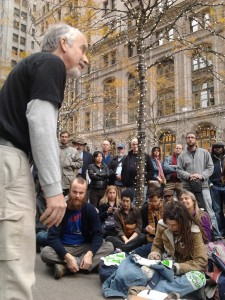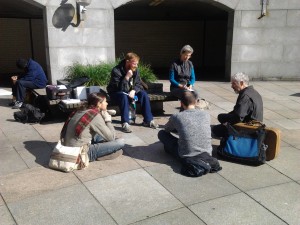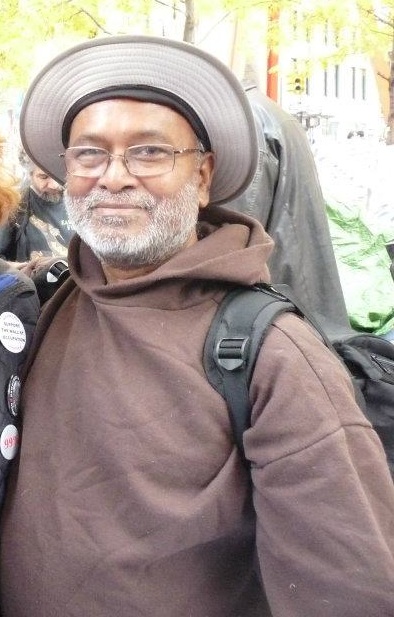Occupy Asks the Classic Consensus Questions
C.T. and I get hundreds of emails each day, many of them from Occupy activists asking the same cluster of questions about consensus. They love their General Assemblies, as I love Intentional Community, and they can’t see abandoning their GA’s, so they’re desperate to make them work. Their hearts are searching for a way to bring the often shouting voices together. We have decided to share one such email, from OWS activist and workshop student Sati, with his permission. Sati’s words are in italics; C.T.’s answers are in regular font. —Wren
On Feb 9, 2012, at 11:45 AM, Satinath Choudhary wrote:
Dear CT,
I got your book – Consensus for Cities. Thank you very much.
You know CT, in as much as I would love to do things with consensus; my faith in consensus appears to be eroding.
C.T.: I understand your concern. Please keep an open mind towards the consensus process. I suspect the versions of consensus you have seen, especially @ OWS, were created by and practiced by people who had little to no prior experience with any consensus process. They nobly created a process from scratch without much help. It took me years to figure out what I know now and I was learning from people who had years of experience before I came onto the scene. And I was a meeting junkie. I literally went to over 1,000 meetings in one year (avg. 3/day)! Few are willing to invest that kind of time to learn something new. But I was willing and I invested the time. The result, the model of consensus I originally called Formal Consensus, then took me additional years to understand fully and to learn how to teach it to others. In fact, after 25 years, I am still learning about this model and how it operates in group dynamics.
Sati: What do you do when you suspect there are plants in a group that would like the group not to reach consensus – it would like the group to fail to make any decisions?
C.T.: This was my experience back in 1985 when I set out to develop a model of consensus that could not be disrupted by agent provocateurs. In the Quaker-based model of consensus I learned as a young activist between 1980-85, the approach to  “blocking” was that any one individual could raise a block and, if the group could not satisfy the concern the block was based on, the proposal was defeated. I recognized that while this might be practical in a faith-based community such as the Religious Society of Friends (Quakers), this as unworkable in radical political groups where we know the State sends disruptors.
“blocking” was that any one individual could raise a block and, if the group could not satisfy the concern the block was based on, the proposal was defeated. I recognized that while this might be practical in a faith-based community such as the Religious Society of Friends (Quakers), this as unworkable in radical political groups where we know the State sends disruptors.
To address this problem generally, I recognize and now teach that requiring new people to go through a process of becoming a member of the group was essential. [Consensus for Cities, 1.1 New Member Orientation pp. 88-89 & 1.10 Membership pp. 97-98.] To address this problem more specifically, I developed the concept that “blocks” must be based on the purpose and common values of the group or contradict an existing decision. [On Conflict and Consensus (Third Ed.) 2.3 The Rules of Formal Consensus – Rule #5 pp. 27.]
Sati: What do you do when a group of people who are just too emotional, they start shouting at each other?
C.T.: The problem is NOT that people are too emotional. Just the opposite; people are emotional. Most groups subscribe to the notion that emotions have no place in group decisionmaking. This comes from the practice of using Robert’s Rules of Order. In this process (commonly referred to as “voting”) there is no place in the structure that allows for the expression of emotions. In consensus, the process does allow for the expression of emotion. However, since most people have experiences of using voting where emotions are “out-of-order”, they have learned to express emotions in inappropriate ways (such as shouting).
Additionally, with forms of consensus where there is little structure, an individual has no way of knowing when or how emotions can be appropriately expressed. In a  formal consensus process, the structure allows for emotional expression during a time when the group dynamics can easily support the individual and NOT at a time when emotional expression are disruptive or difficult to hear.
formal consensus process, the structure allows for emotional expression during a time when the group dynamics can easily support the individual and NOT at a time when emotional expression are disruptive or difficult to hear.
Sati: Consensus appears to fail even in a small group of people, how can we expect it to work in a large group of people like cities?
C.T.: Almost everyone asks me this question and it is precisely why I titled the second consensus book Consensus for Cities. People think consensus process only works in small groups of like-minded, trusting people. If I thought this were true, I would have given up on consensus long ago. Voting is based on power; it is the process of amassing enough power so that your proposal will prevail by gaining majority support. The consensus process that we teach is based on values; it is the process of identifying, articulating and using the common values of the group to determine if a proposal matches the group’s commonly held values or not. If it does, it is adopted, even if only one member wants the proposal; if it does not, it is defeated, even if everyone wants the proposal (unless the group changes their common values to match the proposal). How to do this process is what we teach in the 2-day workshop.
Sati: They can’t even gather together in one place. It seems to me that representative governance just cannot be avoided. Once the group of representatives is down to around 10 or so, we could possibly think of consensus.  But even in that situation, the interest of the super-rich is diagonally opposite to that of poor. How are they going to reconcile with each other?
But even in that situation, the interest of the super-rich is diagonally opposite to that of poor. How are they going to reconcile with each other?
C.T.: Contrary to popular opinion, the model of governance called representative democracy is NOT democratic. The structure of electing representatives who then make the actual decision for the larger group is called an oligarchy. Democracy is participatory or direct. Once you remove the decision making from “the people” or all the members of the group, it is no longer democracy. Consensus is all about direct, participatory democracy.
The interests of the super-rich are based on values, such as hierarchy, individualism, and competition. The values of OWS are egalitarian, collectivism and cooperation. These are two very different groups of people with different sets of common values that are mutual exclusive. The answer to your question is that they are not going to reconcile anything, especially using consensus process.
Sati: You must know that top governing body of Swiss is federal Executive Council (EC) of seven, elected every four years. They have been ruling the country since 1848 using consensus as their mode of working. Even they have abandoned to use consensus in the last four years after their right wing leader Blocher of People’s Party won support of 30% of country’s vote – more than any other party’s.
C.T.: You have exposed my most difficult problem regarding the version of consensus that I teach. Most everyone, including most dictionaries, see consensus as a form of voting, usually by super-majority or even complete, unanimous agreement. This is the kind of consensus the Swiss Executive Council uses (sometimes referred to as consensus-seeking with a majority vote over-ride).
I believe and teach that consensus process is a completely separate process, not based on voting at all. This is a radical perspective and not yet recognized by the over-culture (although, on the Wikipedia page on consensus, it is given a very brief nod by mentioning the Quaker model). It appears all the other models of consensus mentioned rely on voting in some form or other and much of the entry is devoted to various techniques of voting, such as hand signals, unanimity, etc.
I find this all very ironic since, as far as my research into consensus historically goes, in Western culture, all versions of consensus are based on the Quaker version and the Quakers learned it from the Iroquois Confederacy. Interestingly enough, this is mostly denied in the Wikipedia article, primarily based on the racist notion that “savages” could not have developed such a sophisticated process. It is also interesting to note that nowhere on this page is any reference to the Quaker involvement with the Iroquois or the influence of the Quakers on the founding fathers. (I have much more on this I will save for another time.)
Sati: I am yet to have a look into your book. I would like to read both of your books before I come to your workshop on Long Island.
Best regards,
Satinath
Sati will be attending our Consensus: Body and Soul workshop in Manorville, Long Island, February 24-26, 2012. Registration is still open. This will be our last East Coast workshop before we head west for a while. So take advantage of this chance! Contact us at fiopa@consensus.net for a brochure/registration form. —Wren
Post Script: 3/4/12: Sati and several members of OWS’ Vision & Goals working group, as well as Occupy activists from Boston and Philadelphia, participated in the Manorville workshop. Now Sati and other attendees are helping to recruit for another Consensus: Body and Soul workshop, to be held at the WBAI studios at 120 Wall Street, March 10-11. For more information on this new workshop, visit our facebook event page and call Wren at 410-458-2310.
Please join our Hippie Chick Diaries fan page on Facebook!


Leave a Reply
You must be logged in to post a comment.